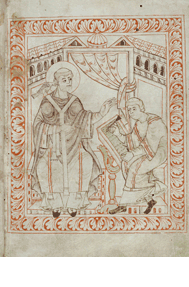GREGORIAN HAGIOGRAPHIES
|
An anonymous monk at Whitby Abbey composed the earliest surviving biography of Gregory in England at the beginning of the 8th century. One of the most important Longobard intellectuals present at the court of Charlemagne at the end of the 8th century, Paul the Deacon (Paulus Diaconus) probably wrote the Vita Gregorii after his retirement to the Abbey of Montecassino. The Vita Gregorii edited by Paul the Deacon (Paulus Diaconus) at the end of the 8th century was subject to an interpolation at the end of the 10th century involving the addition of some chapters of Anglo-Saxon origin. The added episodes narrate the death of Pope Pelagius and Gregory’s return to Rome already on the way to convert the English, his attempts to avoid nomination to the papacy and some miracles performed in Rome. In the Middle Ages this hagiography was attributed often erroneously to the Longobard historian. John the Deacon composed the Vita of Gregory, the most complete and thorough medieval biography of the pontiff, in Rome between 873 and 876.
|


